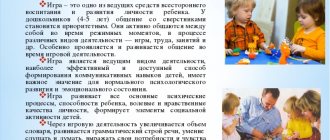The importance of speech development in children at preschool age
The development of speech in children is perceived by many adults as the main indicator of intelligence. This approach is explained by the fact that awareness and logic can be traced in statements and conversation. Of course, thinking and speech as mental processes are closely interrelated. But speech development is only part of the intellectual level of an individual.
At the same time, for a preschooler speech is a multifunctional tool. With its help, he receives information and establishes contact with the outside world. Words help the child consolidate the result of objective activity in his mind. Thanks to speech, children come to perceive and use images.
The speech of a preschooler is egocentric and spontaneous. He speaks more to himself, using repetition and monologue. It's like thinking out loud, with the pronunciation of which comes understanding. Words serve as an activity enhancer and support the child in his actions.
For preschool children, the cognitive and communicative functions of speech are equally important. By listening to adults, they absorb information and discover the world around them. At the same time, children learn to speak and strive to be understood.
Speech development tasks
The psycho-speech development of a child occurs, first of all, due to the natural processes of maturation of the body and the formation of personality. Everything that a baby unconsciously guides while exploring the world is his needs. Adults understand perfectly well that a child must cover a considerable distance in speech development in just a few years. By the time it is time to go to school, a preschooler needs to:
- Know and use many words
- Speak clearly and coherently
- Using speech, receive various cognitive information
- Communicate with peers and adults
The listed tasks are the most important in the speech development of preschool children. They are resolved gradually at each age stage.
What influences the proper development of speech?
There are two groups of factors that influence speech development:
- Biological.
- Social.
The first include various pathogenic factors that can harm proper development: complex intrauterine development, brain infections and injuries, hearing impairment, heredity.
The second group is a combination of the child’s internal development processes and external conditions that are specific to each age stage. For example, the early separation of a baby from his mother sometimes causes emotional instability, impulsiveness, and behavioral disturbances. And this, in turn, leads to speech disorders.
Good conversation is influenced by examples and role models. The child first hears how they speak in the family, so he begins to try it himself. In order to correctly assimilate words during play activities, the child first accumulates impressions - this is the basis for future images and connections with them in speech. The development of gross motor skills also affects the correctness of conversation. The development of speech skills is influenced by the language a child learns to speak. An attempt to master several languages at once may slightly slow down a child’s development; his speech may develop more slowly.
In no case should a child be punished for mistakes in speech, teased or corrected with irritation. This can cause withdrawal and reluctance to try further.
The role of the family in the formation of speech reserve is key. Parents study poems and songs, recitations with their child, teach the child to speak at the right speed, and respond to his attempts to carry on a conversation.
Proper speech development is promoted by:
- Emotionally positive environment;
- Peace of mind in the family;
- Moderate sound communication between loved ones (no shouting);
- Feeling of security in the family;
- Patience of parents towards the child;
- Sensitive and friendly behavior of kindergarten teachers.
Psychological characteristics and stages of speech formation in preschool children
The psychological features of speech development in preschool children are determined by the fact that each year of their life sets its own pace and rhythm. The years of preschool childhood are filled with the development of actions, the formation of mental processes, and the accumulation of emotional experience.
If you compare what a child was like a year ago and what he became a year later, these changes are striking. Speech skills change dramatically over such a period of time. In a child’s active vocabulary, the number of words can almost double, and statements become figurative and emotional. Every year a preschooler moves to a new level of speech development.
Development of child speech from 3 to 4 years old
What kind of speech baggage do children enter the preschool age period with? They already know more than 1.5 thousand words. Their statements contain almost all parts of speech with a predominance of verbs and nouns.
The child is no longer content with showing actions, but strives to describe and explain them in words. Speech at 3-4 years of age is still ungrammatical. Individual words are combined awkwardly, reflecting solely the child's interest, need and desire. No logic or conclusions can be traced at this stage. The sentences are simple and short.
The child’s thinking is still strongly tied to the visual situation and is based on momentary impressions. Therefore, his speech is situational. This means that without external clues in the form of surrounding objects or phenomena, it is difficult to understand what the baby is talking about.
The child’s phonemic hearing has already been formed, but many sounds are not yet pronounced due to complex articulation. It is especially difficult to cope with words where there are several consonant sounds in a row. Children distort such difficult moments or skip them altogether.
Formation of speech skills in children from 4 to 5 years old
A 4-year-old preschooler has a significant vocabulary and actively uses simple sentences. In some sound combinations it is possible to pronounce sibilants, but the pronunciation is still unstable. The child persistently repeats if those around him cannot understand what he is talking about.
An orientation towards the sound of the word is formed. Children begin to come up with meaningless words, but in such a way that they create a funny rhyme: porridge-baby, kitten-potten...
This desire to look for speech analogies is called word creation. It gradually becomes more active, starting from the age of 3, and is most clearly manifested by the age of 4.5-5 years. This is an original practice that helps the child learn a lot about his native language through experimentation. The appearance of word creation is a sign that the preschooler is beginning to acquire primary literacy skills.
By the age of 5, the grammatical structure of speech in statements acquires a new level. The preschooler composes complex sentences, takes into account the order of words, uses words in the appropriate cases, changes by gender and number.
But not all grammatical forms are distinguished yet. Even five-year-olds, without thinking, can use “I’m taller than Kolya,” “my pencil is thinner,” and other similar statements.
Features of speech development of a preschooler aged 5-7 years
Speech skills rise to a new level in older preschool age, when situational simple sentences are gradually replaced by coherent speech.
Speech that is connected by semantic content is called coherent or contextual. This content quite fully reveals the speaker’s thought or intention, and the thought is expressed in consistently and correctly constructed sentences.
The cognitive speech development of older preschoolers allows them to express their thoughts in understandable language. At this age, children speak with a listener in mind.
A 6-year-old learns speech planning. If earlier words accompanied the action or followed them, then in older preschool age they come to the fore. The preschooler first thinks through and tells what he intends to do.
An important achievement is the emergence of speech forms of activity. The older preschooler perceives listening, telling, reading, and reasoning as activities.
How to determine that a child has speech delay
Delayed speech development is a later acquisition of oral speech in comparison with conventional norms for children under 3 years of age. Delayed speech development can be characterized by qualitative and quantitative underdevelopment.
In order to correctly understand how to determine delayed speech development, it is necessary to know the stages and conditional norms of speech development in children at an early age.
Normally, at 1 year of age, a child’s active vocabulary contains approximately 10 words, and the passive vocabulary contains about 200 words. Up to a certain time, the passive vocabulary is much larger than the active vocabulary. Approximately 1.6 - 1.8 months. words from the passive vocabulary burst into the active vocabulary. In some children, the period of passive speech lasts up to 2 years, although in general speech development is normal.
Deviations in speech development within the normal range are allowed for 2-3 months in girls, and 4-5 months in boys. Only a speech therapist can correctly understand whether a child has a speech development delay or not.
Signs of delayed speech development at different stages of speech ontogenesis may be: lack of response to sound and speech, inactive attempts to repeat other people’s words, absence of one’s own speech at different stages of its development, absence of non-speech methods of communication.
Causes of delayed speech development
Why did the child have a delay in speech development? Causes may include disturbances during intrauterine development and the birth process, as well as adverse effects that the child encountered in the first years of his life.
The most severe disorders occur during 3-4 months of intrauterine development. At this time, the fetal nerve cells form brain structures. The causes of delayed speech development in children associated with the course of pregnancy and childbirth can be factors such as early and late toxicosis of pregnancy, extreme prematurity, birth trauma, intoxication with chemicals and drugs. Delayed speech development may be influenced by genetic factors.
Pathologies during pregnancy and childbirth are not always the causes of underdevelopment. Sometimes disorders are caused by factors affecting the health and upbringing of the child - these are reasons of a biological and social order.
Biological factor . Biological factors include complications after vaccination, a slow rate of maturation of the nervous system, as well as long-term diseases that weaken the child’s immunity at an early age. The biological basis of RRD is most often the presence of minimal brain dysfunction in the child caused by perinatal brain damage.
Hearing loss. It is very dangerous if a child has reduced hearing or cannot hear anything. When hearing loss occurs, a child’s speech cannot fully develop. In this case, even minimal deviations from the norm can be considered the cause of RRD. It is very important at what age the baby lost his hearing. If this happened at 5-6 years old, the child can retain speech skills. When a child is born deaf or has hearing loss in the first years of life, the chances of such a child speaking are zero.
Social factors. Such factors include frequent stress, lack of attention and communication in the family.
Prevention
If parents notice that their child’s speech development is lagging behind the norm, then they definitely need to contact the right specialist. Neurologists, speech therapists, defectologists, and corrective teachers are working on solving this problem. In special cases, the help of a facial surgeon or orthodontist may be needed.
In case of impaired understanding of speech, incomplete mobility of the lips, tongue, low level of fine motor skills, if hearing impairment is suspected, the following studies are carried out: hearing test, examination of speech understanding, examination of fine and gross motor skills, examination of articulation organs, examination of vocabulary, examination of phrasal speech.
Based on the results of the examination, the degree of mental retardation is determined and corrective work is planned. How is delayed speech development treated? Drug therapy, magnetic therapy, electroreflexotherapy, dolphin therapy and hippotherapy are carried out; A teacher and proofreader works with the child.
With uncomplicated forms of pathology and with fully completed correctional work, by the time the child starts school, the delay in the development of the child’s speech will be overcome. To do this, it is important that parents support all the requirements and recommendations of specialists.
Measures to prevent speech delay:
- creating conditions for a favorable course of pregnancy and childbirth, the first years of a child’s life;
- the formation of a speech environment rich in educational toys and various objects;
- ensuring normal social conditions for the life and development of the child;
- assessment of speech development by a speech therapist no later than 2-2.5 years.
In order to quickly compensate for delayed speech development, you need to promptly pay attention to the child’s communication problems. There are several degrees and varieties of RRD, which only a specialist can diagnose. He will also find out the possible cause of the development of a speech defect affecting the central nervous system and brain.
Norms of speech development in a preschooler from 3 to 7 years old
The results of studies of the speech of preschoolers make it possible to establish average indicators. Let's consider what levels of speech development are expected at each age stage - for younger, middle and older preschoolers. For convenience, we present the data in a table.
Table. Approximate norms for speech development of preschool children
| Age | Lexicon | Level of speech development |
| 3-4 years | up to 1900 words | Speech is situational, using indefinite forms there, like that. Makes simple sentences. Uses verbs, nouns and pronouns (often demonstrative this, that). Pronunciation: softens the sound, does not pronounce the sound R, less often – L, K, G. replaces hissing sounds with whistling ones. |
| 4-5.5 years | 2000-2500 words | Expands the use of adjectives. Literally understands the meaning of the word. He is interested in the sound of words, composes rhymes and new consonant words. Uses diminutive suffixes. Uses conjunctions a, and, but, as well as subordinates that, when, because... Expresses quantitative and qualitative relationships: many-few, high-low... Pronunciation: overcomes softening, masters almost all sounds, partially copes with the pronunciation of R. |
| 5.5-7 years | up to 4000 words | Speech is coherent and detailed. Composes messages from several sentences united by a common meaning. Builds sentences correctly from a grammatical point of view. Modifies words using suffixes. Masters the declension of nouns and the conjugation of verbs. Sound pronunciation must be correct. |
When to see a speech therapist
There are several conditions under which you need to seek help from a specialist.
- There is no humming or babbling.
- By two years, the vocabulary is completely undeveloped or the child does not speak at all.
- Does not pronounce simple sounds or replaces them (“k” with “t”, etc.).
- If by the age of three the baby speaks a language that only he understands.
- The child understands everything, reacts to everything, but does not speak.
- If at 4-5 years old speech is slurred, many sounds are not pronounced.
- If after the age of five the child continues to speak softly (“kisya”).
- By the age of six, individual sounds are not pronounced correctly.
- Speaks with hesitation, repeats syllables, stutters.
- A child over 6 years old cannot learn a poem or retell what he heard.
The way a child talks speaks volumes about his mental health. And if there are any hints of deviations from the norm, it is best to contact a specialist. He will tell you whether it is possible to straighten your speech at home or whether you need classes with a doctor. If correct speech is not formed by the age of seven, problems with learning and communication may arise, which will reduce the child’s quality of life in the future.
Parents' activity in the development of their child's speech
It is important for parents to consider that each child has his own individual pace of development. Noticing problems in the development of speech in their child in the preschool period and some discrepancy with the norms, they should not jealously compare with others and catch up with their peers, at all costs. However, this issue cannot be ignored.
Parental assistance is necessary for a preschooler in cognitive and speech development. Children, with the support of their parents, successfully progress in the following areas:
- vocabulary formation
- word creation
- development of verbal description skills.
In everyday communication with a child, parents have hundreds of opportunities to use new concepts and explain what they mean. Such simple participation of adults will significantly expand the active vocabulary of a preschooler.
Word creation allows the child to better understand the language and contributes to the development of a sense of rhythm. In addition to benefits in speech development, this activity brings incredible pleasure to children. Emotional speech, joint invention of new words with mom or dad is always accompanied by laughter and a joyful mood.
Parents can successfully teach verbal descriptions to their child. An adult can tell stories and describe what is happening to a preschooler, giving an example of a coherent statement, and then invite him to similarly describe what he sees around him. These activities are easy to do and can be done in any environment - at home or on a walk.
Development of children's speech in different types of activities
The relationship between speech and the content of activity intensifies with age. The need for verbal expression differs in different types of activities.
While playing with his toy, the preschooler conducts a dialogue with it. This one-sided conversation can be internal, not expressed in words. But more often the child says out loud all his calls to his toy friend.
Playing with peers offers other conditions. It is necessary to contact your partner, it is also important to hear him and exchange information. If at younger preschool age verbal communication in the game is simple and may be limited to role-playing participation, then older preschoolers often use explanatory speech.
The speech of a preschooler, which presents a holistic message and fully describes the situation, is called explanatory.
Explanatory speech develops well when preschoolers agree on the rules of the game or coordinated actions and explain the structure of the toy.
The creative activity of a preschooler is also permeated with speech. A child's drawing often needs explanation. And not only due to the fact that the adult asks what is shown on the sheet. More often than not, the author himself wants to tell what he drew. Speech description invariably enriches the content of the picture. Or dots the i's if something incomprehensible is depicted.
With the help of speech, children convey the character of their characters, thus overcoming the limitations of their own artistic abilities.






